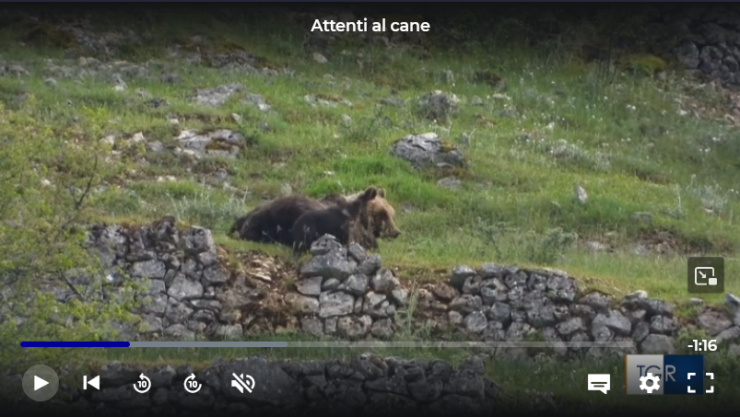Hunters do whatever they want despite the fact that there are clear regulations to avoid anthropic disturbance of the Marsican brown bear and other protected species! While tourists are rightly imposed constraints and bans on observing the animals, thousands of hunters are allowed to go for months with packs of dogs in 83 areas on more than 50,000 hectares of land, much of which is of significant environmental value in the middle of the reproductive and migration period.
The presence of dogs in training constitutes a strong source of stress, disturbance and even predation on ground-nesting species, such as the calander, lark and quail, or among shrubs, such as the woodlark. The bear now has cubs and the presence of dozens of dogs with handlers in tow creates an enormous disturbance factor in critical areas such as those of ecological connection between the parks, particularly in the area between the Simbruini and the Abruzzo, Lazio and Molise National Park and in the upper Sangro between the Abruzzo, Lazio and Molise National Park and the Maiella National Park, in full violation of the PATOM agreement for the protection of the species, so five associations: Salviamo l’Orso, LIPU, Stazione Ornitologica Abruzzese ONLUS, Associazione Altura and CABS Italia, the anti-poaching association, today with a dossier opened the Pandora’s box of the work of the eleven Abruzzo Ambiti Territoriali di Caccia (Abruzzo’s territorial hunting districts) on dog training.
The dossier ‘FAUNA PROTECTION AND DOG TRAINING FOR HUNTING PURPOSES. THE TEMPORARY KEEPING AREAS IN ABRUZZO: A PANDORA’S POT!” of 25 pages offers a detailed account with data and regulatory analysis.
Through forgeries as well as genuine violations of community, national and regional regulations, the ATCs have even quadrupled the areas set aside for dog training in the current Fauna and Hunting Plan, effectively emptying it of meaning. In fact, the Plan recognised 21 permanent dog training areas on a total surface area of 11,864 hectares. Areas where hunting is then closed during the hunting season. Not satisfied with these areas, the ATCs have decided to establish another 83 ‘temporary’ areas on over 50,000 hectares. The record belongs to the ‘Avezzano’ ATC with 20 areas, followed by the ‘Vastese’ ATC with 14, the ‘Pescarese’ ATC with 14, and then the ‘L’Aquila’ ATC with 12. The ‘Subequano’ ATC appears to be the least critical with only one perimeter area.
Establishment measures are usually reiterated from year to year and lapse a few days before the opening of the hunt. With this ploy, for seven months dogs are taken to train and for the remaining five months they are shot, generating an insane anthropic pressure on these areas, which is completely unsustainable for the various species.
Temporary areas should be residual compared to permanent ones. The hunting plan itself requires that the maximum extension of each area be 350 hectares. Instead, at least 42 temporary dog areas exceed this limit, with peaks of areas extending over 2,000 hectares.
Dog training should then end by law on 30 June, but as many as 7 ATCs out of 11 have unilaterally extended the period beyond this deadline.
The location of many of these areas from a naturalistic point of view is disconcerting. As many as four of them, three in the Roveto-Carseolano ATC and one in the L’Aquila ATC, are even identified within Natura2000 sites protected by the EU; 23 are located on the border with Natura2000 sites, in many cases with the Gran Sasso and Maiella national parks and with the Sirente Velino regional park; 21 are within Important Bird Areas defined on a European scale.
Despite this, the mandatory Environmental Impact Assessment procedures based on the EU Habitats Directive 43/92 have not been activated for their identification.
The associations believe that intervention is necessary at various levels, from the regional EIA Committee, which must enforce the prescriptions given at the time to the Fauna Hunting Plan, to the regional hunting office, which must enforce compliance with the plan and the regional law, from the Ministry of the Environment and the parks, which must enforce compliance with PATOM, to the Carabinieri Forestry Officers, who are asked to verify the actions of the ATCs, with particular reference to the lack of the Environmental Impact Assessment, and to carry out strict controls in the field. In the meantime, everything must be cancelled immediately, also by means of self-defence on the part of the ATCs themselves.
The protection of Italy’s wildlife heritage comes before the interests of hunters.
Please find attached the dossier and a summary table with data per ATC.


